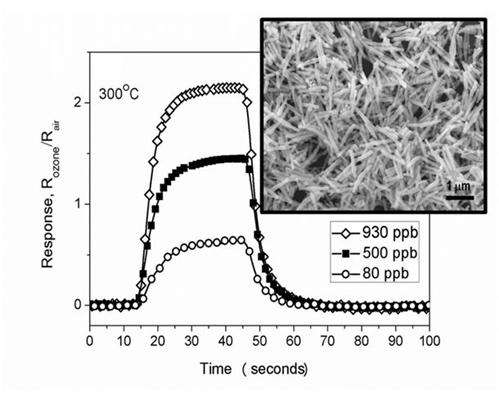New sensor improves the level of efficiency in detecting ozone

Researchers from the Universitat Jaume I in Castelló, the São Paulo State University in Brasil and the Aix-Marseille University in France have developed a more effective ozone sensor than the ones used so far. The new sensor detects this gas faster and in lower amounts. Ozone is present in the atmosphere and it plays a significant role in the protection of living beings because it absorbs the ultraviolet radiation from the sun. However, the exposure to certain concentrations of this gas may cause health problems, such as headache, burning and irritation of the eyes and respiratory system problems; that is why it is relevant to detect its presence effectively.
This sensor ―developed by researchers from the three universities― is based on silver tungstate nanofilaments. The study ―published by the magazine Nanoscale― shows that this new material can be applied as a resistance sensor that produces a good performance in the gas detection. The so called "resistance gas sensors" consist of a material that can change its electrical properties when it comes into contact with the molecules of a gas. In this case, silver tungstate electrical properties have been raised in proportion to the presence of ozone. In fact, the research has been highlighted, because of its innovative nature, by the magazines Material Views and Material Today as a relevant article or "hot paper".
The professor of Physical Chemistry at the Universitat Jaume I, Juan M. Andrés, highlights the importance of detecting the presence of ozone gas. "Despite of being a gas that offers several beneficial applications, such as the protection against harmful solar radiation or its use for water treatment, in certain concentrations it can be dangerous for health". In this sense, the World Health Organisation recommends avoiding the exposure to ozone gas above 120 ppb (parts per billion). The researcher from the Jaume I explains that with the new sensor "a fast response, as well as a very short recovering time, has been observed. It makes its properties even better than traditional sensors based in tin dioxide, tungsten trioxide or indium oxide".
The participation of the UJI lies within one of the lines of research in collaboration with the Instituto Nacional de Ciência e Tecnologia dos Materiais em Nanotecnologia (INCTMN), led by the lecturer Elsón Longo, the doctor Lourdes Gracia ―with a postdoctoral contract in the Department of Physical and Analytical Chemistry at the UJI― and the doctor by the UJI Patricio González-Navarrete, who is currently doing an Alexander von Humboldt postdoctoral stay at the Technische Universität in Berlín (Germany). The researchers at the UJI have developed and applied several methods and techniques of theoretical and computational chemistry, that are based on quantum mechanics, in order to understand and rationalize these nanomaterials properties; not only as gas sensors, but also as bactericides and luminescent sensors to guide the experimental proofs to synthesize new nanomaterials with specific technological applications. This project is a follow-up from the ones previously published in this research field.
More information: Luís F. da Silva, Ariadne C. Catto, Waldir Avansi, Laécio S. Cavalcante, Juan Andrés, Khalifa Aguir, Valmor R. Mastelarob and Elson Longo. "A novel ozone gas sensor based on one-dimensional (1D) α-Ag2WO4 nanostructures". Nanoscale, 2014 6; DOI: 10.1039/c3nr05837a
Journal information: Nanoscale
Provided by Asociacion RUVID



















